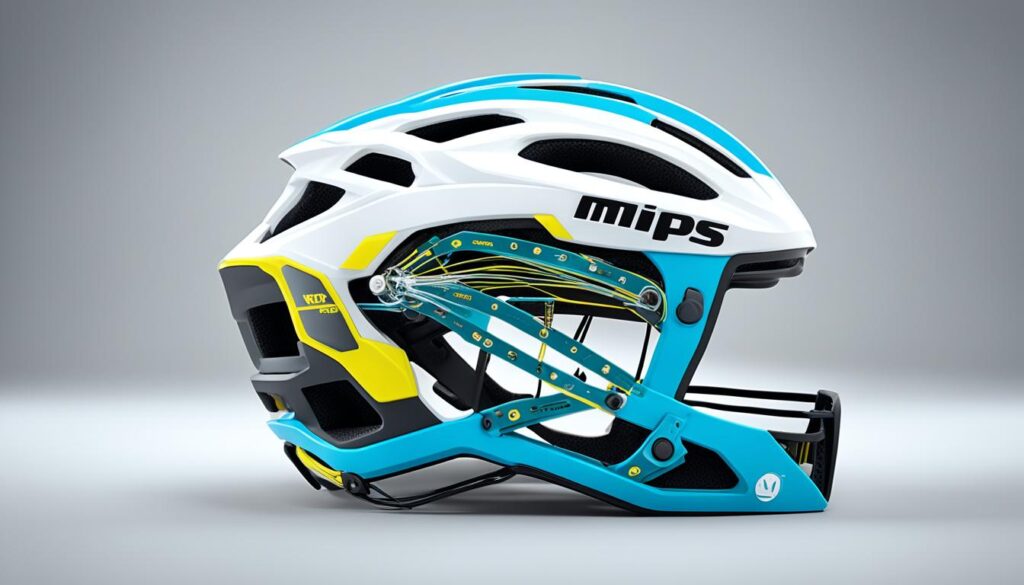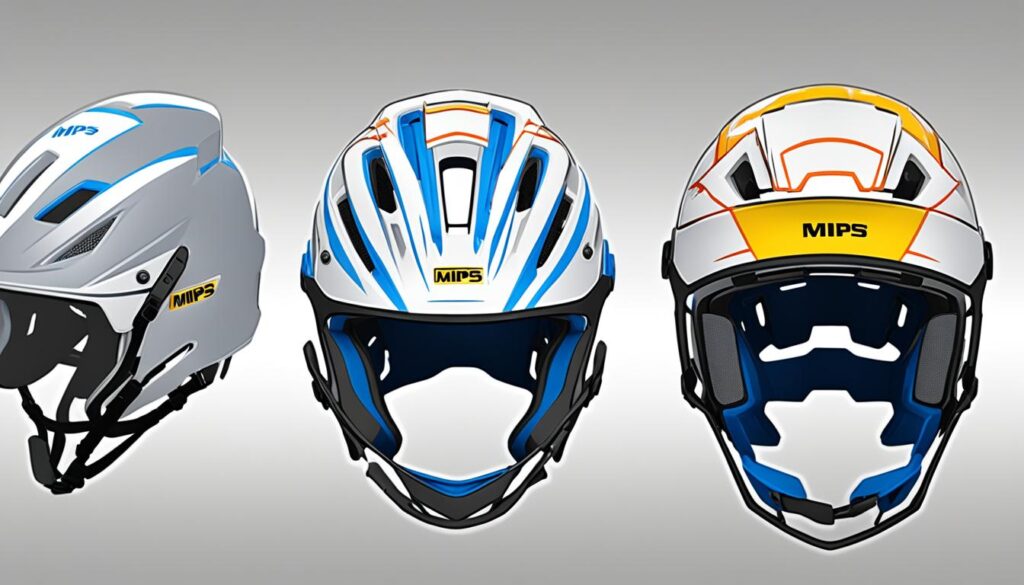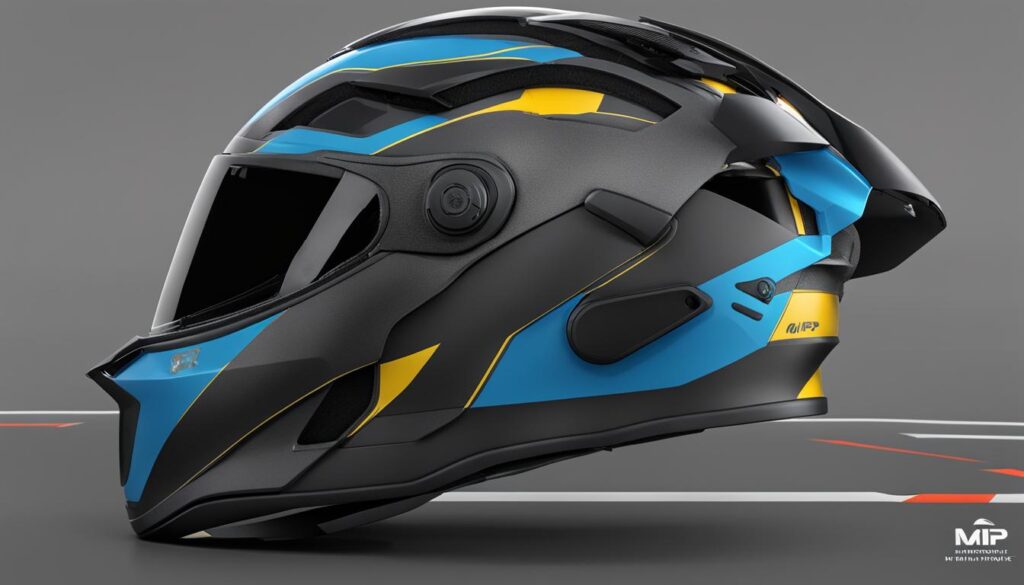
Have you ever wondered how helmet technology is keeping up with our safety needs? We often hear about the importance of wearing a helmet, but what about the specific features and technologies that make them safer? What if there was a helmet technology that could address the rotational forces that occur during impacts and provide enhanced head protection?
Introducing MIPS helmet technology. In this article, we will delve into the world of MIPS and explore how this innovative technology is revolutionizing helmet safety. From understanding how MIPS works to discovering its benefits and limitations, we will uncover the facts behind this game-changing technology.
So, are you ready to explore the world of MIPS and take a closer look at how it enhances our safety?
Key Takeaways:
- MIPS helmet technology addresses rotational forces during impacts.
- MIPS incorporates a low-friction layer to reduce the transfer of rotational motion to the brain.
- MIPS helmets provide enhanced head protection and can potentially reduce the risk of brain injury.
- Choosing the right MIPS helmet involves considering factors such as fit and safety standards.
- No helmet can guarantee complete protection, but MIPS technology offers an additional layer of safety.
What is MIPS?
MIPS, which stands for Multi-directional Impact Protection System, is a safety technology incorporated into helmets across various industries. This includes cycling, equestrian, construction, and motorbike helmets. The key component of a MIPS helmet is the low-friction layer positioned between the EPS foam and the helmet liner.
The purpose of this layer is to allow for a sliding movement of 10 to 15mm in all directions during an impact. This design helps to reduce the transfer of rotational motion to the brain, which is often associated with head injuries. By minimizing rotational forces, MIPS helmets provide enhanced protection against brain injury.
For a visual representation of MIPS technology, refer to the image below:
To summarize, a MIPS helmet incorporates a low-friction layer that enables multi-directional movement. This innovative design helps to mitigate the rotational forces experienced during an impact, ultimately reducing the risk of brain injury.
How does MIPS work?
MIPS technology in helmets is designed to reduce the transfer of rotational forces to the brain, providing enhanced head and brain protection. So, how does a MIPS helmet work?
In a MIPS-equipped helmet, a low-friction layer is inserted between the helmet liner and the head. This layer allows the head to slide relative to the helmet during an angled impact, mimicking the natural protective mechanism of the brain sliding inside the skull in cerebrospinal fluid. By introducing this sliding layer, the helmet can better dissipate rotational forces and help protect the head and brain from potential injury.
The concept behind MIPS technology is to address the reality that impacts can come from various angles, not just head-on. When an impact occurs at an angle, rotational forces come into play, potentially causing shearing and straining of the brain, which can result in various brain injuries.

By incorporating a low-friction sliding layer, MIPS technology provides an additional layer of protection against rotational forces. This allows for a more effective dissipation of such forces, reducing the risk of brain injury.
The inclusion of MIPS technology in helmets aims to improve overall helmet safety by addressing an often overlooked aspect of head protection. By reducing the transmission of rotational forces to the brain, MIPS-equipped helmets offer enhanced head and brain protection in the event of a crash or impact.
Why is protecting against rotational force important?
Protecting against rotational force is crucial because studies have shown that rotational impacts can lead to concussions and serious traumatic brain injuries. While helmets are typically designed to handle linear impacts, they may not provide sufficient protection against rotational forces. Rotational forces can cause shearing and strain on the brain, resulting in various brain injuries. MIPS technology aims to address this issue by reducing the transmission of rotational forces to the brain, thereby helping to prevent or minimize the risk of concussion and other brain injuries.

Rotational forces exerted on the brain during an impact can have severe consequences. The brain is a delicate organ, and any disruption or shearing caused by rotational forces can lead to significant brain injury. The need to protect against rotational forces is especially important in sports and activities that involve high-velocity impacts or potential falls.
MIPS helmet technology offers a promising solution to mitigate the risk of brain injury from rotational forces. By introducing a low-friction layer within the helmet, MIPS enables the head to rotate slightly during an angled impact, reducing the force transmitted to the brain. This innovative design helps to minimize the strain and shearing that can occur, significantly enhancing the helmet’s ability to prevent or reduce the severity of concussions and other brain injuries.
Studies have demonstrated that MIPS helmets can provide notable benefits in terms of reducing the risk of brain injury. By incorporating a sliding layer that allows for multi-directional movement, MIPS helmets effectively dissipate rotational forces and protect the head and brain from potential harm.
It is crucial to recognize the importance of protecting against rotational forces and to choose helmets that integrate MIPS technology. Whether engaging in high-impact sports or participating in everyday activities, wearing a properly fitted MIPS helmet can significantly reduce the risk of brain injury and provide essential head protection.
How effective is MIPS in reducing brain injury?
The effectiveness of MIPS in reducing brain injury is a subject of ongoing research and debate. MIPS, or Multi-directional Impact Protection System, claims that helmets equipped with their technology can provide a minimum of a 10% reduction in rotational forces compared to helmets without MIPS. While this reduction in rotational forces is promising, the actual impact on brain injury prevention can vary depending on the individual and the specific circumstances of an accident.
It is important to note that no helmet, including those with MIPS technology, can completely eliminate the risk of brain injury. However, MIPS helmets do offer an additional layer of protection against rotational forces, which have been linked to concussions and serious traumatic brain injuries.
Continued research is necessary to further understand the effectiveness of MIPS in reducing brain injury and to explore other strategies for improving head protection. In the meantime, it is essential for individuals to wear properly fitted helmets and prioritize their safety in activities that carry the risk of head impacts.
| Pros | Cons |
|---|---|
| Reduces rotational forces by at least 10% | No helmet can eliminate the risk of brain injury |
| Adds an extra layer of protection | Effectiveness varies depending on the individual and accident circumstances |
| Addresses the link between rotational forces and brain injuries | Continued research is needed to fully understand its impact |
What is the history of MIPS?
The development of the MIPS (Multi-directional Impact Protection System) helmet technology can be traced back to 1996 when two researchers, Hans von Holst and Peter Halldin, recognized the limitations of traditional helmets in addressing rotational forces during impacts. They identified the need for a better helmet safety system that could provide enhanced protection against rotational motion and reduce the risk of brain injuries.
Von Holst and Halldin’s research led to the design and development of the MIPS slip plane technology. This innovative system debuted in 2007 with the introduction of MIPS-equipped equestrian helmets. Over time, MIPS technology expanded to other helmet types, including cycling, construction, and motorbike helmets, to improve overall helmet safety standards.
MIPS collaborated with various helmet manufacturers to integrate their technology right from the design stage. By doing so, MIPS aimed to enhance helmet safety standards and ensure that rotational forces are appropriately addressed, reducing the risk of head injuries.
Redefining Helmet Safety Standards
“Through their groundbreaking research, Von Holst and Halldin revolutionized helmet safety by introducing the MIPS slip plane technology. This design innovation prioritizes the reduction of rotational forces, providing advanced protection against brain injuries.” – Helmet Safety Expert
Today, MIPS is recognized as a leader in helmet technology and is widely incorporated by over 120 helmet brands around the world. The founders’ commitment to improving helmet safety standards has led to the widespread adoption of MIPS-equipped helmets, offering users enhanced protection against rotational forces and minimizing the risk of brain injuries.
Meeting Helmet Safety Standards
As part of their commitment to improving helmet safety, MIPS helmets undergo rigorous testing to meet established safety standards. These standards include the requirements set by organizations such as the US Consumer Product Safety Commission (CPSC) and the European Standard (CE).
By meeting these safety standards, MIPS-equipped helmets provide users with greater confidence in the effectiveness and reliability of their headgear, ensuring optimal protection during various activities, including cycling, skiing, or motorcycling.
The Founders of MIPS: Hans von Holst and Peter Halldin
Hans von Holst and Peter Halldin are renowned researchers and pioneers in the field of helmet safety. Their work in developing the MIPS slip plane technology has significantly contributed to advancing helmet safety standards and protecting individuals from the risk of brain injuries.
Both von Holst and Halldin continue to collaborate with MIPS in ongoing research and development efforts, driving innovation and promoting continuous improvement in helmet safety technology.
How does MIPS technology benefit helmet users?
MIPS technology offers a range of benefits to helmet users, enhancing safety and providing peace of mind during various activities. By reducing the transmission of rotational forces to the brain, MIPS helmets offer enhanced head protection during impacts, helping to minimize the risk of concussions and other brain injuries. The inclusion of MIPS technology ensures that helmets have undergone rigorous testing and meet specific standards before being approved by MIPS.
The benefits of MIPS technology in helmets include:
- Enhanced Head Protection: MIPS helmets reduce the transfer of rotational forces to the brain, improving head protection during impacts and reducing the risk of brain injuries.
- Concussion Prevention: By effectively addressing rotational forces, MIPS helmets can potentially reduce the occurrence and severity of concussions, providing greater safety during activities prone to head impacts.
- Testing and Approval: MIPS-equipped helmets undergo rigorous testing and evaluation before being approved by MIPS, ensuring that they meet high standards of safety and effectiveness.
The image below illustrates how MIPS technology enhances helmet safety:

Throughout various industries, MIPS-equipped helmets have become a trusted choice for individuals seeking superior head protection. Whether cycling, skiing, or engaging in motorcycling, the inclusion of MIPS technology in helmets offers users greater confidence, knowing that their headgear meets stringent safety standards and provides added protection against rotational forces.
How do you choose the right MIPS helmet?
When it comes to selecting the perfect MIPS helmet, there are several factors to consider. One of the most important aspects is finding a helmet that fits well and ensures optimal protection. A proper fit ensures that the helmet stays securely in place during an impact, providing maximum safety for your head.
Additionally, it is crucial to look for helmets that have undergone rigorous safety testing and meet recognized standards such as the US Consumer Product Safety Commission (CPSC) and the European Standard (CE). These ratings indicate that the helmet has been tested and certified to provide a certain level of protection.
While MIPS technology can enhance the safety of a helmet, it is essential to note that no helmet can guarantee complete protection from all potential injuries. Despite the advanced features of a MIPS helmet, it is still essential to exercise caution and follow safety guidelines.
When choosing a MIPS helmet, consider your specific needs and preferences. Are you primarily cycling, skiing, or engaging in other activities? Each activity may have different safety requirements, so it’s important to select a helmet that aligns with your intended use. If you are unsure about which MIPS helmet to choose, consult with a professional or trusted source for guidance.
MIPS Helmet Selection Checklist
| Considerations | Details |
|---|---|
| Helmet Fit | Ensure the helmet fits snugly on your head and doesn’t move excessively during activity. |
| Safety Ratings | Look for helmets that meet recognized safety standards such as CPSC and CE. |
| Activity-Specific | Choose a helmet that is designed for your specific activity, such as cycling, skiing, or motorcycling. |
| Professional Guidance | If unsure, consult with a professional or trusted source for personalized recommendations. |
By considering these factors and following the MIPS helmet selection checklist, you can make an informed decision and choose a safe and reliable helmet that offers enhanced head protection.
What are the limitations of MIPS technology?
While MIPS technology offers improved protection against rotational forces, it is important to understand its limitations. MIPS and helmet manufacturers are often cautious about making explicit safety claims due to the potential for litigation. Each individual and accident is unique, making it difficult to determine the exact level of safety provided by a MIPS helmet. Additionally, other factors such as helmet design and fit can impact overall safety. It is essential to recognize that helmet safety is a multifaceted issue, and no single technology can eliminate all risks or guarantee complete protection.
What is the current market status of MIPS helmets?
MIPS technology has gained significant recognition in the helmet market. There are currently over 120 helmet brands incorporating MIPS safety systems into their products, offering consumers a wide range of options for enhanced head protection. With over 729 MIPS-equipped helmet models available, individuals have ample choices to find a helmet that suits their needs and preferences.
The demand for MIPS helmets is evident in the sales figures, with an impressive 7.3 million units sold in 2020 alone. This indicates the growing acceptance and trust in MIPS technology as a reliable solution for addressing rotational forces and improving overall helmet safety.
The market response to MIPS technology reflects its relevance in the industry and its ability to cater to the safety needs of helmet users. As the market continues to evolve, it is expected that MIPS-equipped helmets will remain a prominent choice for individuals seeking advanced head protection.
Highlighted below are some key details about the current market status of MIPS helmets:
- Over 120 helmet brands incorporate MIPS safety systems
- 729 MIPS-equipped helmet models available
- 7.3 million MIPS helmets sold in 2020
MIPS technology has established itself as a significant player in the helmet safety market due to its effectiveness in addressing rotational forces and improving overall helmet safety. With the support of numerous helmet brands and increasing sales, MIPS-equipped helmets are becoming a popular choice for individuals seeking enhanced protection.
Market Status of MIPS Helmets
| Market Data | Statistics |
|---|---|
| Number of helmet brands using MIPS | Over 120 |
| Number of MIPS-equipped helmet models | 729 |
| MIPS helmet sales in 2020 | 7.3 million units |
MIPS in other industries
While commonly associated with cycling helmets, MIPS technology has extended its application to other industries. In addition to cycling helmets, MIPS is used in equestrian helmets, construction helmets, and motorbike helmets. The goal is to provide greater head protection across various activities and potential impact scenarios. By incorporating MIPS technology into helmets used in different industries, it demonstrates its versatility and potential to improve safety standards across a range of applications. Whether on a bike, a construction site, or engaged in motorsports, individuals can benefit from the added protection offered by MIPS technology.
Benefits of MIPS Technology in Different Industries
Equestrian Helmets:
- Improved protection against rotational forces during falls or direct impacts
- Reduced risk of head and brain injury in the event of a riding accident
- Enhanced stability and comfort for riders
Construction Helmets:
- Increased head protection in hazardous work environments
- Minimized risk of head injuries from falling objects or impacts
- Improved safety compliance and adherence to industry standards
Motorbike Helmets:
- Enhanced head and brain protection during high-speed riding
- Reduced risk of rotational forces causing severe head injuries
- Improved helmet stability and fit for optimal rider safety
Incorporating MIPS technology in helmets used in equestrian, construction, and motorbike industries provides individuals with greater head protection and helps minimize the risks associated with rotational forces and impacts. By prioritizing safety in these industries, MIPS technology contributes to reducing the occurrence and severity of head injuries in various scenarios.
Table: Comparison of MIPS Helmet Applications in Different Industries
| Industry | Primary Purpose | MIPS Benefits |
|---|---|---|
| Equestrian | To protect riders from head injuries during falls |
|
| Construction | To provide head protection in hazardous work environments |
|
| Motorbike | To ensure rider safety during high-speed riding |
|
Future advancements in helmet safety
Helmet safety technology is constantly evolving, driven by ongoing research and development efforts in the pursuit of enhanced head protection. Researchers and manufacturers are dedicated to exploring innovative materials, designs, and technologies that can further improve helmet safety and effectiveness.
Advancements in helmet safety encompass multiple areas, including:
- Impact Absorption: Researchers are investigating new materials and design techniques to improve a helmet’s ability to absorb and distribute impact forces. By optimizing impact absorption, helmets can provide even greater protection against head injuries.
- Ventilation: Improved helmet ventilation systems are being developed to enhance comfort and reduce heat buildup during physical activities. Proper ventilation can help prevent overheating and promote better overall helmet usage.
- Enhanced Protection Against Rotational Forces: Building upon technologies like MIPS, researchers are exploring new methods for reducing rotational forces during impacts. By further minimizing the transfer of rotational motion to the brain, helmets can offer increased protection against brain injuries.
The future advancements in helmet safety will likely result in helmets that are lighter, more comfortable, and provide improved overall protection. Ongoing research and development efforts in the field of helmet safety ensure that individuals will have access to the best possible head protection in the years to come.
As advancements in helmet technology continue, it is essential for helmet users to stay informed about the latest developments and choose helmets that incorporate these advancements. By selecting helmets that are backed by research and innovation, individuals can prioritize their safety and enjoy their activities with peace of mind.
The importance of wearing a helmet
It cannot be stressed enough how crucial it is to wear a helmet for head injury prevention. Wearing a helmet significantly reduces the risk of severe head injuries during accidents. Whether you’re cycling, skiing, or participating in any activity that carries the potential for head impact, a properly fitted helmet provides critical protection.
Incorporating advanced safety technologies like MIPS enhances helmet safety, but their effectiveness relies on consistent helmet usage. The habit of wearing a helmet should be ingrained as part of safety practices, promoting a culture of protection and ultimately minimizing the occurrence and severity of head injuries.
“A helmet is the most important piece of safety equipment any athlete can wear. It can prevent life-threatening brain injuries and save lives.”
– Dr. Michael Cusimano, Neurosurgeon and Researcher
The Key Benefits of Wearing a Helmet:
- Head Injury Prevention: Helmets offer vital protection against head injuries, reducing the risk of severe trauma to the head and brain.
- Peace of Mind: Wearing a helmet provides a sense of security and confidence, allowing individuals to fully enjoy their activities without constant worry about potential head injuries.
- Role Modeling: When adults consistently wear helmets, they set an example for children and reinforce the importance of helmet use from an early age.
By prioritizing helmet use, we can ensure better overall safety and create a society where head injuries are minimized. Remember, wearing a helmet is not just a personal choice; it’s a smart decision that can protect you and your loved ones from the devastating effects of head injuries.
Conclusion
MIPS helmet technology offers enhanced safety by addressing rotational forces during impacts. By incorporating a low-friction layer, MIPS helmets can reduce the transfer of rotational motion to the brain, potentially reducing the risk of brain injury. This groundbreaking technology provides an additional layer of head protection and has become widely recognized in the helmet industry.
While MIPS technology is a valuable advancement in helmet safety, it is important to consider other factors when choosing a helmet. Proper fit is crucial to ensure optimal protection, and helmets should meet recognized safety standards such as CPSC and CE. It is also important to acknowledge that no single technology can eliminate all risks or guarantee complete protection. However, the inclusion of MIPS technology in a well-fitting helmet can significantly enhance safety.
Ultimately, the goal is to choose a helmet that not only incorporates MIPS technology but also fits well and meets safety standards. By wearing a helmet consistently during activities such as cycling, skiing, or motorcycling, individuals can promote head injury prevention and ensure their personal safety. MIPS helmet technology has made significant contributions to helmet safety, and ongoing advancements in the field will continue to enhance head protection for years to come.
Source Links
- https://mipsprotection.com/helmet-safety/
- https://velo.outsideonline.com/road/road-gear/mips-the-reality-behind-making-helmets-safer/
- https://www.bikeradar.com/advice/buyers-guides/what-is-mips
Recommended

Meet James Smith, affectionately known by friends as ‘Biker Smith’, your go-to expert at ‘Best HD Helmet Camera’. At 35, living in the USA, James embodies the spirit of adventure. His life is a thrilling ride, powered by his Harley Davidson Softail and BMW S 1000 RR, with his girlfriend as his favorite travel companion. A software developer by profession, James’s heart beats for the open road, making him a full-time traveler at heart. His passion for biking and technology merges seamlessly on this platform. Recognizing a gap in discussions around helmet cameras, he founded this blog to educate and inspire fellow enthusiasts. His mission? To elevate your riding experience with the best HD helmet camera insights, backed by firsthand experiences, rigorous testing, and a genuine love for the ride. Trust James to guide you through the world of helmet cameras, where quality, innovation, and safety ride together.